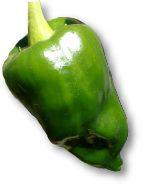
Greek Myrtle Seeds
 Scientific Name: Myrtus communis
Scientific Name: Myrtus communisCommon Name: Greek Myrtle
Other Common Names: Arrayan, As, Greek Myrtle, Lampsana, Mersin, Murt, Murtek, Myrtle, Sweet Myrtle, Yas, Myrtle, Foxtail Myrtle, Roman Myrtle, Clove Myrtle, Bride’s Myrtle, Sweet Myrtle, True Myrtle, Spanish Myrtle, Sweet Roman Myrtle, True Roman Myrtle, Vilaayati Mehndi & habb-ul-Aas
Plant Type: Perennial
Where To Plant: Full Sun to Partly Shady
Soil Types: Average
Zones (See US Zone map): 11+ or Green house
Germination: Hard
Number of Seeds Per Pack: 25
Uses: Culinary
Notes: Spicy leaves can be used in cooking like the bay leaf. Slow to germinate.
MYRTUS COMMUNIS. Classic evergreen shrub from the Mediterranean. Fragrant white flowers and leaves are unique in potpourris and sachets. Spicy leaves can be used in cooking like bay leaf. Lovely house plant. Slow to germinate.
Price: $3.95/pkt
To Mail In Your Order Please Use The Mail-In Order Form

Greek Myrtle in the Garden
Myrtus communis, commonly called Greek Myrtle, is an evergreen shrub that can grow up to 15 foot tall in it's native habitat. If you use it as an indoor plant then the plant will not usually get much larger than 2-3 foot. The plant itself branches profusely and has lots of bunched up pointy dark green, shiny, oval leaves that are fragrant upon being crushed. Greek Myrtle flowers also smell heavenly and come forth in the summer.
Greek Myrtle is a popular plant for a topiary. A topiary is a plant that is pruned into a specific shape. This has been going on since Roman times. The shapes can be made to look like geometric shapes or even animals because this plant has small leaves. Some people also like to train it to grow as a small container bound Bonsai. Overall, it takes pruning very well and is commonly used as a hedge.
Germinating Greek Myrtle (Myrtus communis) Seed
There are two methods. The first method is what I do. I like to sow in winter in pots with peta moss in the cold winter. A lot of people say to do it at the winter soltice, but just make sure it gets the old treatment that it would see in nature.
The second method of germinating Greek Myrtle seed also works and it involves cold treatment. In this method, you first soak the seeds for a full 24 hours. Then put in a small amount of damp sand in a plastic ziplock bag and store in the bottom of your fridge (40F/4C) for 1-2 months. Get it out, and then sow in a flat of Jiffy-7 pellets (or even just a flat of seed stating mix) and seed germination will happen in 14-21 days. Once the Myrtus communis seed are up, it is recomemnded that you plant in rich, slightly moist (not too wet) soil with partial to sun. I usually start my small plants in first year in 5 gallon pot. Do make sure they get enough sun as they will get spindly in too much shade. Also it is not a good idea to fertilize young mytle plants in first 3 months after germination.
Growing Greek Myrtle from seed may seem a bit more difficult to germinate when compared to germinating other herb seeds, but with a gardener's patience and by doing it like mother nature does it, your attenpts at germinating Myrtus communis will achieve success. You will have some beautiful seedlings reaching for the sun and bringing you years of enjoyment from it's beautiful foliage & fragrant flowers. It can also be grown as an indoor plant. Greek Myrtle overall is simply a beautiful plant with a wide of uses beyond just a scrub.
Myrtus communis Care - Caring for your Greek Myrtle Seedling / Plant
Do not fertilize seedlings until the plant is well established. Fertilizer can help an older plant but be too mush for the young myrtle seedlings. Growing conditions that are best suited for the myrtle would be moist (not wet), well-drained soil that's moderately fertile. Loves full sun but can tolerate part sun. Hardiness zone of 8 to 9. Will flower in Late Summer to Early Fall producing solitary white flowers followed thereafter by dark purplish-black berries that birds love. Plants can grow up to 10 feet. Can be pruned very well and often used as a topiary plant.
Myrtus communis Uses
Greek Myrtle, Myrtus communis, is well loved worldwide because of its ornamental, medicinal, and culinary uses. Around the world, Myrtus communis, commonly called Greek Oregano, is cultivated and treasured by cultures around the world. Nowhere is this more prevalent than in the Mediterranean regions where this beatiful shrub flourishes.
On the Mediterranean islands of Sadinia and Corsica, Myrtus communis is used to create an aromatic liqueur called Mirto. The leaves and berries are macerating in alcohol to produce two different types of drinks, a red and white beverage. In the Mediterraneans, pork dishes are often stuffed with myrtle sprigs to give meat flavor. The berries are also used a pepper substitute. Used to impart flavor to meats like Mortadella and even American Bologna. In Calabria, dried figs are often baked on a Myrtle branch for a tasty flavor it imparts to the fruit.
The purplish-black berries of the Greek Myrtle are known throughout the Middle East as mursins. Mursins are dried and ground down for a culinary seasoning that imparts flavor to stews or can be boiled into a delicious jelly or beverage treat!
The Myrtus communis plant also is used to create essential oil. Used in perfumery & other beauty products, the leaves, bark and flowers are all used to produce sweet smelling soap & other beauty products. The leaf extracts are used in hair tonics, perfumes, and a wide range of cosmetic products.
Medicinal uses include use in urinary infections, vaginal discharge, sinus issues, digestive problems, diabetes and the essential oil is used as antibiotic, antidiarrheal, aromatic, antiseptic, astringent, carminative, balsamic, tonic & haemostatic and therefore is common in aromatherapy. The berry juice have been used on reddened iritated newborn skin. The essential oils are used to clear up skin acne. It is an immune system booster. It can stimulate urination and help purify the kidneys.
Myricetin is a key compound found in the flavonols of the Greek myrtle. It has been found to inhibit the formation of beta-amyloid fibril, potentially helping prevent Alzheimer’s and other forms of dementia. The flavonoids have also been proven to be powerful antioxidants that help lower cholesterol for good heart & circulatory health.
Greek Myrtle In History
Greek myrtle, as a plant in general, is revered throughout the Mediterranean region as a symbol of peace and love. It was thought that the plant was sacred to the goddess of love, Aphrodite. As a result, it is often used in wedding bouquets there.
Gold Myrtle wreath was found in the antechamber of the royal Macedonian tombs at Vergina, Greece originating from the Hellenistic period (300-30 BC). The gold wreath is thought to belong to Meda, the Thracian princess and fifth wife of Philip II of Macedon. Even though real myrtle plants were not used in the gold wreath, it does demonstate the importance placed on the symbolism of the plant in ancient days. The gold was shaped to look like myrtles in bloom, which was a very delicate job to produce something so fine.
Myrtle tree symbolism - The symbolism of the myrtle "tree" is prevalent in Judaism as well for it is one of the 4 sacred plants in the Jewish Festival of Tabernacles(Sukkoth). The Sukkoth requires the myrtle stem that is used to have three leaves growing from one point in the branch. Christians often point to this as being symbolic of the holy trinity.
In Bible times, the myrtle was abundant and in Nehemiah 8:15, we read that Nehemiah said that the myrtles grew on the hills about Jerusalem.
By the way, Greek Myrtle is conpletely different plant than the Crepe Myrtle! Believe it or not, we get asked that a lot.
Grow your own Greek Myrtle from seed
Scroll up and order your myrtus communis seeds today! Occassionally we may have myrtus communis plants for sale, but those are usally sold when we hold an herb walk.
Any statement made concerning medical
conditions treated with this herb is not intended as sound medical advice but informational only. The seeds we sell are NOT to be ingested only planted. Herbs need to taken only with
the guidance of a trained physician or established herblist.
|
|
Here is a sample of some of the herbs that we have.  Mountain Mint | Mouse Ear Hawkweed | Mugwort | Mulberry | Mullein | Munstead Lavender | Munstead Lavender | Musk Mallow | Musk Mallow | Narrow Leaf Mountain Mint | Nepitella | New England Aster | Niebita | Nigella | Omega Flax
|
link to us| about sand mountain herbs.com
| faq
questions or comments? send us feedback.
copyright © 2002- Sand Mountain Herbs
all rights reserved
Website Interactive

 For full list visit
our
For full list visit
our
 Hi,
this is Larry Chandler. Owner of Sand Mountain Herbs. How would you like to
Hi,
this is Larry Chandler. Owner of Sand Mountain Herbs. How would you like to
 I promise your email address will never be sold or given to any third party.
I promise your email address will never be sold or given to any third party.